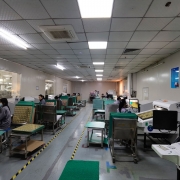Ilustrovaná historie desek s plošnými spoji
Ilustrovaná historie desek s plošnými spoji
První desku s plošnými spoji (PCB) vyvinul ve 30. letech 20. století Paul Eisler, který vystudoval strojírenství a předtím, než se začal věnovat elektrotechnice, pracoval jako redaktor časopisu. Eisler přišel s nápadem, že tisk na papír by se mohl používat nejen pro noviny. Tuto myšlenku rozvíjel v malém jednopokojovém bytě v londýnském Hampsteadu.
Moe Abramson
Historie desek s plošnými spoji byla ovlivněna mnoha technologickými trendy. Jedny z prvních desek plošných spojů vytvořil Moe Abramson, počítačový inženýr, který pomohl vyvinout proces automatické montáže. Abramson také vyvinul vzory propojení měděných fólií a techniky ponorného pájení. Jeho postup byl později zdokonalen a jeho práce vedla ke standardnímu postupu výroby desek s plošnými spoji.
Deska s plošnými spoji je obvod, který mechanicky nese a elektricky spojuje elektronické součástky. Obvykle se vyrábí ze dvou nebo více vrstev měděných plechů. Její výrobní proces umožňuje vyšší hustotu součástek. Má také pokovené průchozí otvory pro elektrické spoje. Pokročilejší desky plošných spojů obsahují také vestavěné elektronické součástky.
Stanislaus F. Danko
Historie desek s plošnými spoji sahá až do poloviny 20. století. Předtím měly elektronické součástky drátové vývody a byly připájeny přímo na stopu desky plošných spojů. První proces automatické montáže vyvinuli Moe Abramson a Stanislaus F. Danko, kteří byli členy amerického signálního sboru. Tento postup si nechali patentovat a od té doby se stal standardní metodou výroby desek s plošnými spoji.
Desky s plošnými spoji jsou důležitou součástí elektronických zařízení. Od svých skromných počátků v polovině 19. století se staly běžnou záležitostí. Jejich vývoj byl poháněn rostoucími požadavky spotřebitelů. Dnešní spotřebitelé očekávají od svých elektronických zařízení okamžitou odezvu. V roce 1925 vyvinul Charles Ducas postup zvaný "tištěný drát", který měl snížit složitost zapojení. Dr. Paul Eisler sestrojil první funkční desku plošných spojů v Rakousku v roce 1943.
Harry W. Rubinstein
Historii desek s plošnými spoji do značné míry ovlivnil muž jménem Harry W. Rubinstein, který v letech 1927 až 1946 pracoval jako vědecký pracovník a vedoucí pracovník divize Centralab společnosti Globe-Union. Rubinstein byl v Centralabu zodpovědný za několik inovací, včetně vylepšených kolečkových bruslí, zapalovacích svíček a akumulátorů. Jeho nejslavnějším vynálezem však byl tištěný elektronický obvod.
Historie desek s plošnými spoji začíná na počátku 20. století, kdy se elektronické součástky pájely na desky plošných spojů. Deska plošných spojů měla otvory pro vodiče, které se skrz tyto otvory zasunuly a poté připájely k měděným stopám na desce. V roce 1949 však Moe Abramson a Stanislaus F. Danko vyvinuli techniku, která spočívala ve vkládání vodičů součástek do propojovacího vzoru z měděné fólie a jejich ponorném pájení. Tento postup později převzala americká armáda U.S. Signal Corps a nakonec se stal standardním způsobem výroby desek s plošnými spoji.
Komponenty pro povrchovou montáž (SMT)
SMT je technologie, která umožňuje aplikovat elektronické součástky přímo na povrch desky s plošnými spoji (PCB). To umožňuje efektivnější výrobu a kompaktnější design. Snižuje také počet vrtaných otvorů, což může vést ke snížení výrobních nákladů. Součástky SMT jsou také robustnější a vydrží vyšší úroveň vibrací a nárazů.
Hlavní výhodou technologie povrchové montáže oproti průchozím součástkám je vysoká míra automatizace a snížení počtu poruch během procesu svařování. Kromě toho je balení součástek SMT mnohem levnější než balení jejich protějšků THT, což znamená nižší prodejní cenu. To je obrovská výhoda pro ty zákazníky, kteří hledají velkoobjemové desky s plošnými spoji.
Více vrstev mědi
DPS s více vrstvami mědi jsou vyrobeny z více vrstev měděné fólie a izolačního materiálu. Vrstvy mědi mohou představovat souvislou měděnou plochu nebo mohou představovat samostatné stopy. Vodivé měděné vrstvy jsou vzájemně propojeny pomocí průchodek, což jsou tenké kanálky, které mohou vést proud. Tyto vodivé vrstvy se často používají ke snížení elektromagnetického rušení a k zajištění jasné cesty zpětného proudu. Níže jsou uvedeny některé výhody použití mědi na deskách s plošnými spoji.
Vícevrstvé desky plošných spojů jsou nákladnější než jednovrstvé. Jejich výroba je také složitější a vyžaduje složitější výrobní proces. Navzdory vysokým nákladům jsou oblíbené v profesionálních elektronických zařízeních.
Elektromagnetická kompatibilita
Elektromagnetická kompatibilita (EMC) je důležitým aspektem návrhu výrobku. Normy EMC jsou předpokladem pro zajištění bezpečného provozu výrobků. Návrh desky plošných spojů musí být elektromagneticky kompatibilní s jejími součástmi a okolím. Desky s plošnými spoji obvykle nesplňují normy EMC při prvním průchodu. Proto by se proces návrhu měl od počátku soustředit na splnění norem EMC.
Existuje několik běžných technik pro dosažení elektromagnetické kompatibility. Jedna z metod zahrnuje umístění zemnící vrstvy na desku plošných spojů. Další metoda zahrnuje použití zemnících mřížek, které zajišťují nízkou impedanci. Velikost prostoru mezi mřížkami je důležitá pro určení zemní indukčnosti desky plošných spojů. Dalším způsobem, jak snížit elektromagnetické rušení, jsou Faradayovy klece. Tento postup zahrnuje nahození země kolem desky plošných spojů, což zabraňuje signálům, aby se šířily za hranici uzemnění. To pomáhá snížit emise a rušení produkované deskami plošných spojů.


